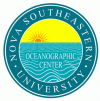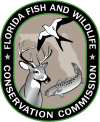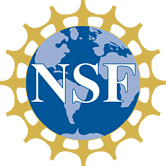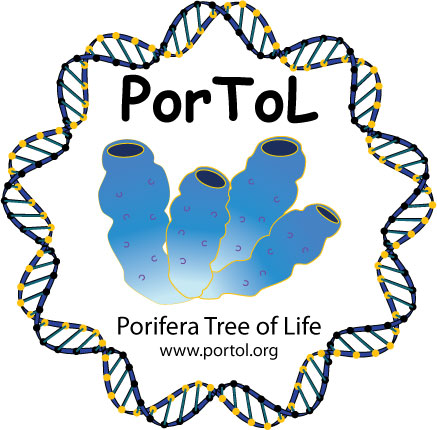Sponges ...
- are among the least complex members of the animal kingdom;

- have no organs or tissues, though they do have many different kinds of cells;
- have no distinct front, back, dorsal or ventral surface (though a few are radially symmetrical);
- are built around a system of canals and chambers that allows them to filter large volumes of water;
- have unique collar cells with a flagellum that drives water through the canals and chambers, and can move up to ten
times the sponge's body volume of water in an hour;
- feed chiefly on particles the size of bacteria or smaller;
- digest their food within cells, not inside a body cavity such as a stomach;
- almost all produce a supportive mineral (silica or calcium carbonate) or organic (protein fiber) skeleton, or both;
- are individuals, not colonies;

- have separate sexes, or change sexes as they grow;
- can reproduce asexually through buds or fragments that can give rise to another individual;
- grow into a distinctive shape or vary widely depending upon factors such as currents, seafloor configuration or
turbidity;
- mostly live in the ocean (a few live in freshwater), attached to the seafloor for most of their lives (although their
larvae can crawl or swim);
- range in size from almost microscopic to over 3.5 meters across;
- harbor diverse communities of bacteria with which they maintain unique relationships that may involve mediating
bacterial metabolisms, and carrying out processes such as photosynthesis or nitrification;
- probably number over 15,000 species (7,000 have been described scientifically);
- often require microscopic examination of skeletal structures for identification.
Sponges in South Florida ...
- are widespread, common and often dominant components of shallow-water marine communities;

- number over two hundred species;
- occur in every local shallow marine habitat, including reefs, seagrass beds, rocky bottoms, sandy bottoms, and
mangroves;
- often far outnumber coral species and represent a greater percent of living biomass in local reef and rocky bottom
habitats;
- are well known but still include many undescribed species.
This guide ...
- offers practical identifications of the shallow-water marine sponges of southern Florida from Indian River Lagoon
through the Florida Keys, Florida Bay and the Dry Tortugas, including species from all shallow-water habitats;
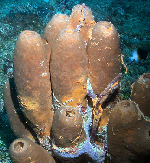
- includes in situ color photographs documenting both typical growth forms and variations, and photographs and drawings
of microscopic features necessary for accurate final identification;
- contains keys and descriptions with simplified technical terms suitable for non-specialists including environmental
managers, marine biologists, teachers and advanced students;
- provides several layers of features both for quick overview assessments and more detailed investigations;
- was funded by generous grants from the National Coral Reef Institute (Nova Southeastern University), Florida Fish and
Wildlife Conservation Commission, and Protect our Reefs License Plate grant program (Mote Marine Laboratory, Sarasota, FL).
Uncredited photographs were all taken by Charles G. Messing's laboratory (Nova Southeastern University).
- is maintained by the Department of Computer and Information Sciences at the University of Alabama at Birmingham as part of the Porifera Tree of Life (PorToL).
To use this guide ...
- click the link to Identification Guide; you will find three sets of menus that refer to three different
sets of sponge characteristics, with different image types. External Form menu selections retrieve underwater or laboratory
photos of whole sponges, and refer to external morphological characters. Mineral Skeleton (Spicules) selections bring up
microphotographs and drawings of skeletal spicules and refer to their characteristics. Fibers and Skeletal Architecture
selections retrieve photos and drawings of spongin fibers and sections through the skeleton, and refer to the particular
arrangement of the skeletal elements (spicules and/or fibers) in the sponge;
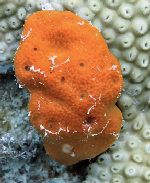
- click on any character menu, e.g., Growth Form, to activate a drop-down list of character state choices, e.g.,
branching or massive;
- select one choice from multiple drop-down menus to narrow your search and click on the "Search for matching species"
button. For example, selecting choices from Growth Form (e.g., branching), Surface (e.g., conulose), Consistency (e.g.,
compressible) and External Color (e.g., yellow) will call up images of fewer species than fewer choices;
- you do not have to select a choice from every menu;
- submit separate searches for the three main menu sets, that is, do not submit a single search that includes choices from,
say, both External Form and Fibers and Skeletal Architecture;
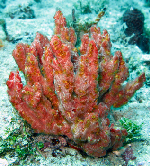
- click on any image produced by your search to bring up that species' page, which includes a description, images,
spicules and skeletal architecture, habitat and ecological data. Pages may also have images linked to other similar species;
- you can also go directly to a particular species page by clicking on a name on the species list.
- click on the "Reset all category values" button to clear your search and start another;
- click on information (I) buttons if you are uncertain about a character state to activate pages that describe the
character choices in greater detail with images (because one person's "bushy" might be another's "branching"). Not all menus
have this feature, e.g., Consistency and Exudate choices are not represented by images.
|
|
CONTRIBUTORS
Charles G. Messing,
National Coral Reef Institute, Oceanographic Center, Nova Southeastern University
Purushotham V. Bangalore,
Department of Computer and Information Sciences, University of Alabama at Birmingham
Maria Cristina Diaz,
Museo Marino de Margarita, Isla Margarita, Venezuela
Christopher J. Freeman,
Department of Biology, University of Alabama at Birmingham
Kevin E. Kohler,
National Coral Reef Institute, Oceanographic Center, Nova Southeastern University
John K. Reed,
Harbor Branch Oceanographic Institute at Florida Atlantic University
Klaus Ruetzler,
Department of Invertebrate Zoology, National Museum of Natural History, Smithsonian Institution
Robert W. Thacker,
Department of Biology, University of Alabama at Birmingham
R W M (Rob) van Soest,
Zoölogisch Museum Amsterdam
Janie Wulff,
Department of Biological Science, Florida State University
Sven Zea,
Universidad Nacional de Colombia - CECIMAR
|

